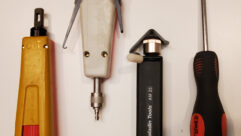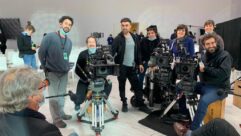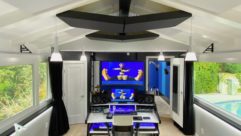
Picture This: Brilliant Lights
Dec 1, 2007 12:00 PM,
By Jeff Sauer
The future of LED is burning brighter.

The Samsung 81 Series LCD HDTV, pictured here, employs LED backlighting instead of CCFL for truer color presentation. This technology modulates the brightness of groups of LED across different sectors of the screen within individual frames.
The Rockefeller Center Christmas tree has been a tradition in New York City for more than 75 years. Actually, this is the 75th year for a tree at Rockefeller Center. In 1932, the second year of the tradition, there was no tree due to construction on the site. The first 1931 tree, a Balsam Fir, was just 20ft. tall; the 1933 tree was more than double that size at 50ft.; and the 1934 tree was 75ft. tall. Today, the tree is generally between 75ft. and 90 ft. tall, including this year’s 84ft. Norway Spruce, but there have been trees as tall as 100ft. at Rockefeller Center.
That 75ft. tree back in 1934 was a spectacle in its day, with roughly 1,200 multicolored lights, and there were 2,000 lights on twin trees when the Rockefeller Center skating rink opened in 1936. In the 1960s through the 1970s, the number of lights grew into the thousands, and then into the tens of thousands in the 1980s. Today, the tree regularly has some 30,000 lights on more than five miles of insulated wire, as is the case with this year’s tree.
However, this year’s Rockefeller Center Christmas tree has one noteworthy difference. Instead of more common incandescent Christmas tree bulbs, it’s bedecked with 30,000 multicolored LEDs in a variety of shapes and designs. It’s an effort to go green, and the new energy-efficient bulbs are expected to consume 40 percent less electricity than past displays, according to Rockefeller Center owner Tishman Speyer. That would make for a daily savings of what an average house uses in roughly a month.
What’s more, a solar farm of 363 panels now sits atop Rockefeller Center to power the lights on the Christmas tree. In recent years, the lights on the tree have been turned off in the early morning hours, but this year, thanks to the use of renewable energy, the tree is expected to remain on 24 hours a day.
TURNING ON THE LIGHTS
The idea of using LEDs in unique places may not be all that foreign to custom installers. Because LEDs are so small, it’s becoming increasingly possible to be rather innovative with custom lighting, such as using lighting strips on or under shelving, or accents in the form of lit shapes, or direct-colored lighting around a larger room, including residential and retail installations. However, when most of us in the video display industry think of LEDs, it’s probably more common to think of them in conjunction with LED-backlit displays — and there are an increasing number of examples.
Texas Instruments has turned to LEDs as the backlight solution for increasingly narrow RPTVs, beginning with Samsung’s 56in. and 61in. 1080p models, now available at retail. LEDs are also the light source of 1lb., palm-sized, DLP-based personal pico projectors that have been available from Mitsubishi, Boxlight, and others for a couple of years.
LEDs are being used as the backlight for high-end LCD panels from companies such as eCinema and Sony. In fact, Sony’s BVM-L230 Trimaster video/color reference monitor, introduced at NAB in April, uses an arrayed LED backlight to ensure the truest color accuracy possible, and it targets some of the best eyes in Hollywood and the world as potential users. By mixing and grouping individual green, red, and blue, the Trimaster will be able to continuously recalibrate itself to specific white point and, in turn, yield consistent color over time.
At CEDIA this past September, Samsung debuted a new series of LED-backlit LCDs ranging in size from 40in. to 57in. However, Samsung is doing more than leveraging the truer color properties of LEDs. Samsung’s SmartLighting technology actually modulates the brightness of groups of LED across different sectors of the screen within individual frames. The goal is to maximize contrast not as the typical ratio between white and black, but to maximize the more appropriate sense of contrast that comes from the breadth of levels of gray within a screen. Intriguingly, while there is a price premium, these newer LED-backlit panels cost only a few hundred dollars more than Samsung’s CCFL models.
BRIGHTER LIGHTS
Yet as exciting and important as those LED-backlight developments are to the display industry, displays ultimately represent a very, very small percentage of the potential market for LED makers. But maybe that’s not such a bad thing, because the real market has a lot more money to reinvest in the technology.
The use of LED lighting stripes in custom room installations is actually a more relevant harbinger of LEDs’ future. LED makers ultimately envision encroaching on, if not taking over, the massive incandescent light-bulb business. Of course, they are not there yet. Consumer LED Christmas lights, for example, have been available at retail for a few years now, and the reports have been decidedly mixed. There are online reports of inconsistent colors (for example, blues that don’t match other blues on the same string), corrosion within the lighting fixtures, unavailability of replacement bulbs, uneven brightness, etc.
However, in the big picture, those troubles are likely to be more an indication of the technology’s growth out of infancy rather than critical long-term flaws. When those palm-sized pico projectors were first introduced almost three years ago, they were lucky to achieve 15 lumens to 20 lumens of brightness. Today, 100 lumens to 200 lumens is clearly on the horizon. It’s a result of money being reinvested — not just to make a few tiny projectors brighter — but with the proverbial carrot of replacing every light bulb in the world.
The good news for those pico projectors — and for larger, brighter projection systems over time — is that LEDs are really just emerging from their infancy. While efficiency has grown considerably, LED companies believe that they are just scratching the surface of LEDs’ potential in terms of all the benefits — such as longer life, energy efficiency, no inherent white bias, and small physical size.
This year’s Christmas lights are likely to be a good deal more reliable than those from years past. Indeed, the use of LEDs to light the famous Rockefeller Center Christmas tree this year marks a coming of age for the technology. It shows that LED technology has now reached a level of reliability to be displayed on the most famous Christmas tree in the country and a level of popular culture’s mainstream — and that will only bolster R&D. It does not mean that those pico projectors are likely to jump up to 500 lumens to 1000 lumens right away. It’s just not as far-fetched as it once seemed.










